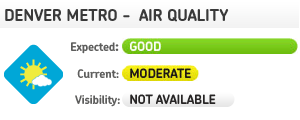Ozone (2015 8-Hour Standard)
Current Status:
Nonattainment – Moderate Area*
Adams, Arapahoe, Boulder, Broomfield, Denver, Douglas, Jefferson, Weld and portion of Larimer county
Attainment Deadline
August 3, 2024
*EPA finalized reclassification to Moderate October 7, 2022
Summary
In April 2018, the U.S. Environmental Protection Agency (EPA) finalized designations, with an effective date of August 3, 2018. The Denver Metro/North Front Range Area (DM/NFR) area was designated as a Marginal nonattainment area with an attainment date of August 3, 2021 (based on the three-year average of monitored ozone values from 2018 through 2020). Based on 2018 – 2020 ozone monitoring data the area failed to attain the 2015 Standard by the Marginal area attainment date and, as such, on October 7, 2022 the EPA finalized the reclassification of the DM/NFR nonattainment area to Moderate under the 2015 Standard with an attainment date of August 3, 2024.
State Implementation Plan (SIP) Documents
Serious Area SIP Documents
| Title | Date Last Updated |
Moderate Area SIP Documents
| Title | Date Last Updated |
| Moderate State Implementation Plan for the DM/NFR Nonattainment Area for the 2015 Ozone National Ambient Air Quality Standard – Adopted by AQCC on December 16, 2022 | December 2, 2022 |
| Moderate SIP Executive Summary – Adopted by AQCC on December 16, 2022 | December 5, 2022 |
| Draft SIP Chapters Presented to RAQC Board | August 2022 |
| Technical Support Documents | December 2022 |
Federal Rules and Actions
Standard
Proposal to Maintain Current Ozone Standard (85 FR 49830, Aug. 14, 2020)
Revised 8-Hour Ozone Standard (80 FR 65292, Oct. 26, 2015)
Designations and Classifications
Finalized Reclassification to Moderate (October 7, 2022)
Proposed Reclassification to Moderate (April 13, 2022)
Additional Revised Air Quality Designations for the 2015 Ozone NAAQS (November 30, 2021)
Designation of Marginal Nonattainment area (June 4, 2018)
Colorado’s Recommendations (Dec. 20, 2017)
State Implementation Plan Approvals
Infrastructure SIP Approvoal – Remanded Portions ( 87 FR 27050, May 06, 2022)
Infrastructure SIP Approval (85 FR 20165, Apr. 10, 2020)
Implementation Rules
Final Rule (81 FR 62998, Dec. 06, 2018)
Proposed Rule (81 FR 81276, Nov. 17, 2016)
RAQC Comments (Feb. 13, 2017)
Colorado Department of Public Health and Environment (CDPHE) Comments (Feb. 13, 2017)
Classification Rule (83 FR 10376, March 1, 2018)
Proposed Rule (81 FR 81276, Nov. 17, 2016)
Other Documents of Interest
Ozone Summary Tables (updated weekly during ozone season)
For more information, see RAQC’s “SIP Planning Process and Colorado SIP Summaries” document

